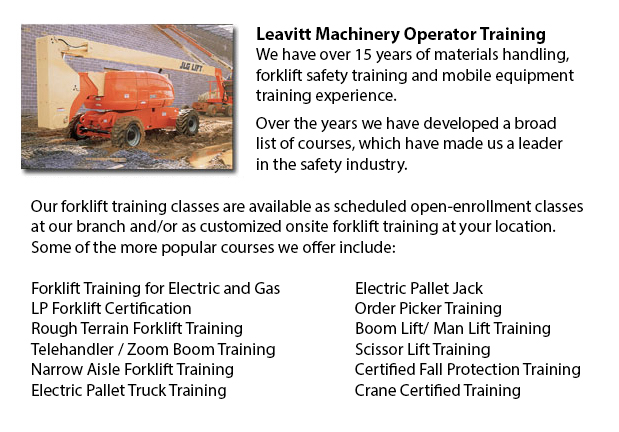
Vernon Aerial Lift Safety Training - Each and every year, there are about 26 construction deaths attributed to the utilization of aerial lifts. Nearly all of the craftsmen killed are electrical workers, laborers, painters, ironworkers or carpenters. Nearly all deaths are caused by electrocutions, falls and tip-overs. The greatest risk is from boom-supported lifts, such as bucket trucks and cherry pickers. Most deaths are connected to this type of lift, with the rest involving scissor lifts. Other hazards consist of being thrown out of a bucket, being struck by falling things, and being caught between the lift bucket or guardrail and a thing, like for example a joist or steel beam.
To be able to safely operate an aerial lift, perform an inspection on the following things before making use of the device: operating and emergency controls, safety devices (e.g., guardrails and outriggers), personal fall protection gear, and tires and wheels. Look for possible leaks in the air, fuel-system, hydraulic fluid. Check the device for loose or missing parts.
The places that worker will use the aerial device should be examined thoroughly for potential dangers, like for instance holes, bumps, debris and drop-offs. Overhead powerlines need to be monitored and avoided. It is suggested that aerial lift devices be used on stable, level surfaces. Never work on steep slopes which exceed slope limitations which the manufacturer specified. Even on a slope which is level, outriggers, brakes and wheel chocks must be set.
Businesses must provide their aerial lift operators with the right manuals. Operators and mechanics should be trained by a qualified person experienced with the applicable aerial lift model.
Aerial Lift Safety Guidelines:
o Close doors or lift platform chains prior to operating.
o Do not climb on or lean over guardrails. Stand on the floor of the bucket or platform.
o Use the provided manufacturer's load-capacity limitations.
o Utilize work-zone warnings, such as cones and signs, when working near traffic.
If proper procedures are followed, electrocutions are preventable. Stay at least 10 feet away from whatever power lines and licensed electricians should de-energize and/or insulate power lines. Individuals working must use personal protective tools and equipment, like a bucket which is insulated. Nonetheless, an insulated bucket does not protect from electrocution if, for instance, the worker touches a different wire providing a path to the ground.
When inside the bucket, workers need to prevent possible falls by securing themselves to the guardrails by making use of a full-body harness or a positioning device. If there is an anchorage inside the bucket, a positioning belt together with a short lanyard is acceptable.
By following the manufacturer's instructions, tip-overs could be prevented. Never drive the lift platform when it is elevated, unless the manufacturer specifies otherwise. Adhere to the device's vertical and horizontal reach limitations, and never exceed the specified load-capacity.
-
Vernon Heavy Equipment Training Programs
Vernon Heavy Equipment Training Programs - At whatever given construction site, there are often different types of machinery which are ready to be used. These heavy and light machines need both operators to run them and mechanics to fix them. Trainee... More -
Vernon Forklift Safety Training
Vernon Forklift Safety Training - People wanting work in industries that operate lift trucks should undergo a forklift safety training program before becoming a certified operator of a lift truck. There are a lot of ways to go about acquiring forklif... More -
Vernon Aerial Boom Lift Ticket
Vernon Aerial Boom Lift Ticket - Aerial platform lifts can accommodate various odd jobs involving high and tough reaching places. Normally used to complete regular preservation in structures with tall ceilings, prune tree branches, elevate heavy shel... More -
Vernon Manlift Safety Training
Vernon Manlift Safety Training - Manlift operators need to be cognizant and aware of all the potential dangers which are associated with particular classes of scissor lifts. They need to be able to operate the scissor lift in a way that protects not... More -
Vernon Forklift License
Vernon Forklift License - Obtaining a forklift certification or forklift license in North America will require the one training to carry out hands-on training in addition to classroom instruction. The provincial, federal and state regulatory bodies a... More -
Narrow Aisle Forklift, Order Picker, Electric Pallet Jack, Electric Pallet Truck Certification in Vernon
A pallet lift is a model of equipment dedicated in the transporting of pallets of many dimensions and weights. They can be utilized as an appendage for forklifts, cranes and other styles of heavy machinery or be applied on their own. Pallet hoists ar... More -
Vernon Boom Lift Safety Training
Vernon Boom Lift Safey Training - Boom lifts are a type of elevated work platform or aerial lifting device which are commonly utilized in construction, industry, and warehousing. Boom lifts can be utilized in practically any surroundings because of t... More -
Vernon Manlift Operator Training
Vernon Manlift Operator Training - The aerial lift or manlift is a specialized kind of hydraulic platform that is designed to lift a person vertically giving it an alternate name of a vertical personnel lift. These machinery are widely utilized for a... More

Forklift Certification Vernon
TOLL FREE: 1-888-254-6157
Vernon, British Columbia
forkliftcertificationvernon.com
Email Us
About Us


